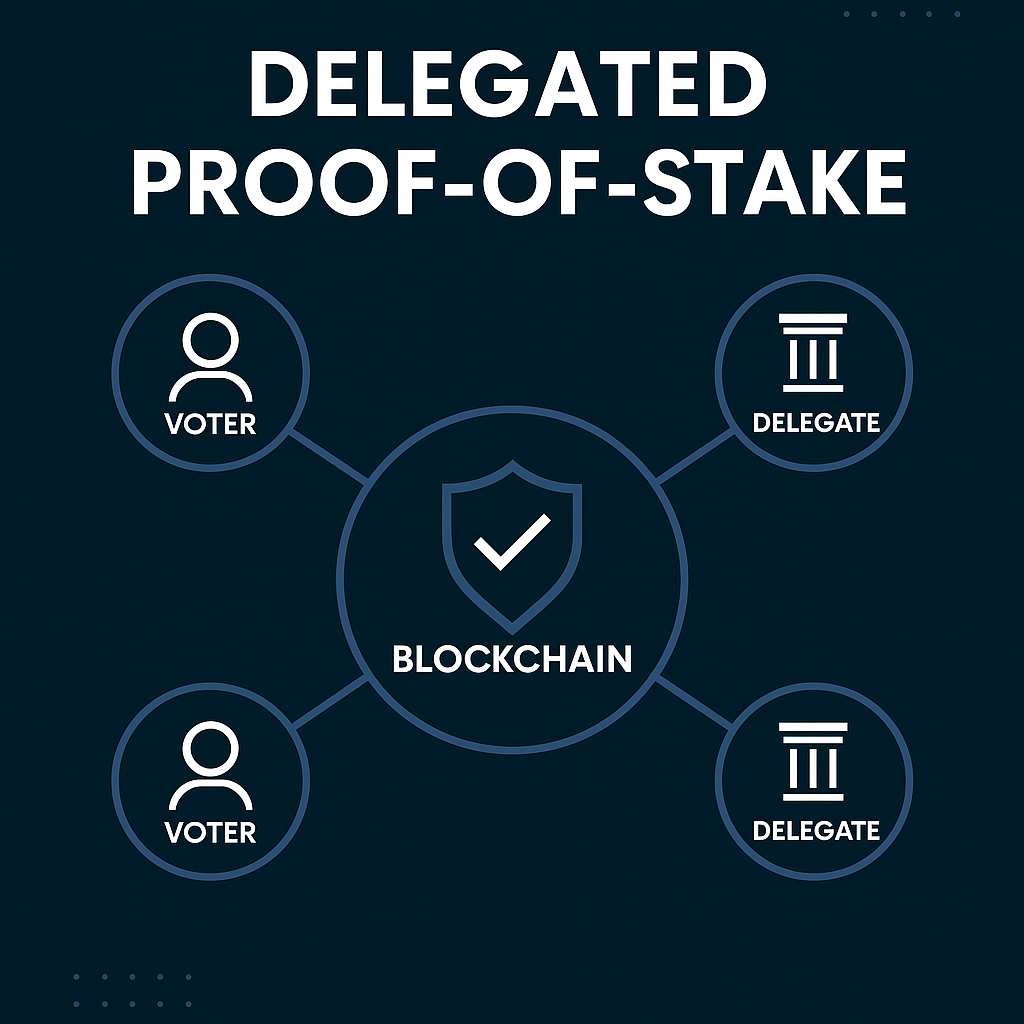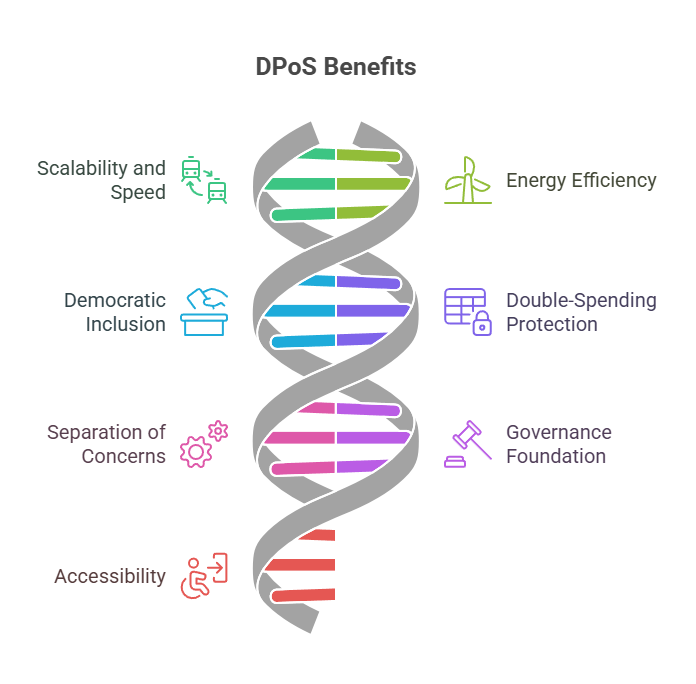Delegated Proof-of-Stake

Delegated Proof-of-Stake
Delegated Proof of Stake (DPoS) is a blockchain consensus method that extends PoS. It was established in 2014 by BitShares, Steemit, and EOS developer Daniel Larimer. DPoS’s main objective is to address some of the speed and scalability issues that traditional PoS systems may experience as their participant count increases. It seeks to offer a more democratic, scalable, and effective method for validating transactions and producing blocks.
How Delegated Proof of Stake (DPoS) Works
A democratic election process is used by the DPoS consensus mechanism to select the nodes in charge of block verification. Here is a thorough explanation of how it operates:
Voting and Delegation:
- As “witnesses” or “block producers,” DPoS token holders choose delegates.
- Voters can vote directly or through a third party.
- How many votes each voter casts depends on their stake. Users have the option to bind their tokens to a certain delegate and combine them into a staking pool. It is crucial to remember that a staking service provider is used in this process rather than directly moving coins to another wallet.
- Users with relatively small stakes can be elevated to the top tier by the votes of users with larger stakes, therefore having a substantial investment is not a prerequisite for becoming a top-tier witness.
You can also read What Is Ethereum 1.0? Initial PoW Blockchain & ETH Evolution
Delegate Selection and Responsibilities:
- Depending on how many votes they earn, a certain, finite number of delegates are selected. Usually capped, this number might vary from 21 to 101, depending on the blockchain.
- The task of validating transactions and generating new blocks falls to these elected delegates. They alternately create new blocks, ensuring a quicker and more effective transaction procedure.
- The block is missed, transactions remain unverified, and the witness does not receive any compensation if they do not confirm every transaction within the allotted period. Such a missed block is referred to be “stolen” and the prize for it is added to the reward of the subsequent witness who confirms it.
- When a majority of block producers vote on a block (2/3 + 1), the block is considered final. A block cannot be undone after it has been added.
- Witnesses are unable to alter the details of any transaction, but they can stop some transactions from being included in a block.
Incentives and Penalties:
- Block rewards, which typically consist of transaction fees, are given to delegates who successfully create new blocks. According to their stake, the users who voted for that delegate are then usually given a percentage of this payment. A user’s part of the block reward increases with their stake amount.
- Witnesses must lock a portion of their stake in order to maintain accountability; if they act maliciously or try to attack the blockchain, this portion is taken away. In a similar vein, a validator forfeits their investment and is barred from participating in the future if fraudulent activity is found.
- Delegates in the top tier are always in danger of being replaced by users who receive more votes and are regarded as more reliable because voting is an ongoing process. Witnesses are kept in control by the fear of losing their money, financial stake, and reputation.
Other Roles in the DPoS System:
- Delegates (Governance): In addition to producing blocks, users elect a different set of delegates to manage blockchain governance. Although they are not involved in transaction control, these governance delegates have the authority to suggest modifications, such as altering the block size or witness payment amounts. Users of the blockchain vote on whether or not to accept these changes after they are presented.
- Block Validators (Full Nodes): To confirm that blocks produced by witnesses adhere to the consensus rules, any user can execute a block validator (full node). Being a block validator has no immediate benefits.
You can also read Unique Node List UNL: A Balance of Centralization & Trust
Benefits of Delegated Proof-of-Stake

Benefits of Delegated Proof-of-Stake
For involvement and performance, DPoS has many benefits:
- High Scalability and Speed: By limiting the number of active validators/delegates (e.g., 20-100), DPoS can process a significantly higher volume of transactions per second (TPS) and achieve faster transaction times and reduced network latency compared to Proof of Work (PoW) or traditional PoS systems. This makes it suitable for commercial applications requiring large-scale participation.
- Energy Efficiency: DPoS eliminates the need for the energy-intensive mining process found in PoW, requiring less power and hardware to run the network. This makes it more sustainable, cost-effective, and environmentally friendly.
- Democratic and Financially Inclusive: DPoS empowers token owners to run elections and the network. It is also more financially inclusive because to the smaller stake amount needed to participate. Because it is founded on established reputation as a legitimate staker rather than merely wealth, it enables a wider range of people to join.
- Protection from Double-Spending: DPoS blockchains are well-protected against double-spending.
- Separation of Concerns: DPoS separates the election of block producers from the block production itself, which can lead to more creative solutions for both aspects.
- Foundation for Governance Models: It offers a framework for incorporating intriguing governance ideas into blockchain applications, creating a kind of democracy.
- Accessibility: Since no expensive or specialised equipment is required, anyone can serve as a delegate.
Disadvantages of DPoS
Despite its advantages, DPoS also has potential drawbacks:
- Centralization Risks: Although having fewer witnesses and delegates speeds up proceedings, it may also result in a concentration of power. Network decentralisation may be threatened and the network may become susceptible to vote buying or delegate collusion if a small number of powerful token holders possess a substantial share of the voting power. Compared to PoW or pure PoS, this may lead to reduced node diversity.
- Dependent on Voter Participation: Delegators must be knowledgeable and regularly participate in the voting process for the network to function and make decisions. A tiny group may be able to control decision-making due to low voter turnout or voter apathy. Smaller stakeholder users may also feel their vote is unimportant and choose not to cast one.
- Malicious Delegates: Elected delegates run the possibility of banding together to censor transactions, control the network, or distribute harmful upgrades. If the majority of delegates behave maliciously, it might be a “51% attack.” In order to take control, malicious actors may even bribe delegates.
- Anonymity and Privacy: By requiring nodes to reveal their genuine identities throughout the voting process, certain DPoS systems may impede privacy and enhance centralization.
You can also read EEA Blockchain: Enterprise Ethereum And Industry Standards
Comparison with Other Consensus Mechanisms
DPoS vs. Proof of Work (PoW):
- Energy Consumption: PoW demands high computational power and energy for mining, while DPoS is far more energy-efficient and does not require mining.
- Speed: PoW is slower due to its mining process, whereas DPoS offers faster transactions by limiting the number of delegates.
- Decentralization: PoW has many miners, but DPoS has fewer delegates, encouraging centralisation.
DPoS vs. Proof of Stake (PoS):
- A vote and delegation method is introduced in DPoS, which is a progression of PoS.
- Scalability: DPoS attains greater scalability with fewer delegates than traditional PoS systems, which can lag when using a large number of validators.
- Governance: Unlike PoS, which frequently lacks organised user governance, DPoS allows token holders direct control over delegate elections.
- Security Risks: Although both depend on financial incentives, DPoS may be more vulnerable to power concentration because there are fewer active participants. Usually, PoS systems select validators at random or according to the size or age of their stake.
DPoS vs. Nominated Proof of Stake (NPoS):
- Both DPoS and NPoS entail voting for participants to validate blocks and two different kinds of network users. The elected participant in DPoS is referred to as a “delegator” (also known as a witness or block producer). A “Nominator” is the selected validator in NPoS.
- One significant distinction is that with NPoS, both validators and nominators must provide collateral and face consequences for inappropriate activity. Only validators, witnesses, or block producers are usually penalised for bad behaviour in DPoS; delegators are generally held accountable for the deeds of malevolent validators. One blockchain that uses NPoS is Polkadot.
Delegated Proof of Stake Examples
DPoS is the consensus mechanism used by a number of well-known blockchains, which place an emphasis on user involvement, scalability, and efficiency:
- EOS: With 21 witnesses, it is well-known for its high throughput and inexpensive transaction costs.
- TRON: With 27 Super Representatives (SRs) nominated as witnesses, TRON focusses on creating a decentralised internet.
- BitShares: Daniel Larimer’s 2015 implementation of DPoS, which had 101 witnesses.
- Daniel Larimer also launched Steemit or Steem, which employs 21 witnesses.
- With 101 witnesses, Lisk is a framework for creating decentralized apps (dApps).
- Ark: Employs fifty-one witnesses.
- Hive: A blockchain-based social media network.
- Sui: Created by former Meta engineers, it features a predetermined group of validators chosen by SUI owners according to their stake size.
- Tezos: Also uses DPoS.
- Cardano: While often cited for PoS, some also list it under DPoS implementations.
To conclude, DPoS is a fast, scalable, and user-engaged consensus method for blockchains with multiple transactions. Plan and include the community to avoid centralisation and voter turnout.
You can also read BFT Meaning, How Does BFT Works And Applications
